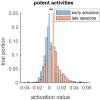Rhesus monkeys learn to control a directional-key inspired brain machine interface via bio-feedback
- PMID: 38232123
- PMCID: PMC10793883
- DOI: 10.1371/journal.pone.0286742
Rhesus monkeys learn to control a directional-key inspired brain machine interface via bio-feedback
Abstract
Brain machine interfaces (BMI) connect brains directly to the outside world, bypassing natural neural systems and actuators. Neuronal-activity-to-motion transformation algorithms allow applications such as control of prosthetics or computer cursors. These algorithms lie within a spectrum between bio-mimetic control and bio-feedback control. The bio-mimetic approach relies on increasingly complex algorithms to decode neural activity by mimicking the natural neural system and actuator relationship while focusing on machine learning: the supervised fitting of decoder parameters. On the other hand, the bio-feedback approach uses simple algorithms and relies primarily on user learning, which may take some time, but can facilitate control of novel, non-biological appendages. An increasing amount of work has focused on the arguably more successful bio-mimetic approach. However, as chronic recordings have become more accessible and utilization of novel appendages such as computer cursors have become more universal, users can more easily spend time learning in a bio-feedback control paradigm. We believe a simple approach which leverages user learning and few assumptions will provide users with good control ability. To test the feasibility of this idea, we implemented a simple firing-rate-to-motion correspondence rule, assigned groups of neurons to virtual "directional keys" for control of a 2D cursor. Though not strictly required, to facilitate initial control, we selected neurons with similar preferred directions for each group. The groups of neurons were kept the same across multiple recording sessions to allow learning. Two Rhesus monkeys used this BMI to perform a center-out cursor movement task. After about a week of training, monkeys performed the task better and neuronal signal patterns changed on a group basis, indicating learning. While our experiments did not compare this bio-feedback BMI to bio-mimetic BMIs, the results demonstrate the feasibility of our control paradigm and paves the way for further research in multi-dimensional bio-feedback BMIs.
Copyright: © 2024 Zhang et al. This is an open access article distributed under the terms of the Creative Commons Attribution License, which permits unrestricted use, distribution, and reproduction in any medium, provided the original author and source are credited.
Conflict of interest statement
The authors have declared that no competing interests exist.
Figures








References
-
- Balasubramanian K, Southerland J, Vaidya M, Qian K, Eleryan A, Fagg AH, et al. Operant conditioning of a multiple degree-of-freedom brain-machine interface in a primate model of amputation. In: 2013 35th Annual International Conference of the IEEE Engineering in Medicine and Biology Society (EMBC); 2013. p. 303–306. - PubMed
MeSH terms
LinkOut - more resources
Full Text Sources

